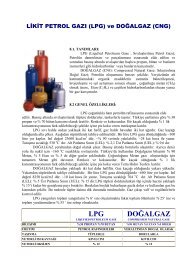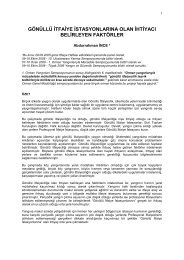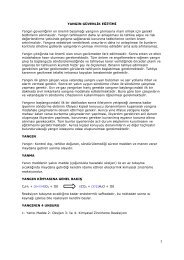buradan - Yangın
buradan - Yangın
buradan - Yangın
Create successful ePaper yourself
Turn your PDF publications into a flip-book with our unique Google optimized e-Paper software.
TÜYAK BİLDİRİLER KİTABI<br />
2009 PROCEEDINGS BOOK<br />
So traditionally we have protected cold areas (both inside and<br />
outside buildings) with air filled systems. When the sprinkler<br />
operates, the air is released which in turn automatically opens<br />
the main water alarm valve and the water follows the air into the<br />
system and to the sprinkler.<br />
This kind of system called a dry-system is used all over the world<br />
but just like standard warehouse protection, when the storage<br />
height reaches certain level you are required to install in-rack<br />
sprinklers.<br />
Dry ESFR System<br />
Figure 24. A photo of a typical dry-ESFR installation.<br />
So can we take advantage of the ESFR in a cold storage environment?<br />
Until recently the answer was no. ESFR’s rely on fast activation and<br />
fast application of the water in order to work and due to the delay in<br />
waiting for the air to leave the system these dry-systems systems<br />
are too slow to allow the use of ESFR sprinklers.<br />
Figure 25. Dry ESFR system<br />
8<br />
TÜYAK 2009<br />
Standard<br />
temperature<br />
void above<br />
Freezer<br />
However, by attaching the ESFR sprinkler to a short length of steel<br />
pipe and adapting the operating mechanism we can now create a<br />
‘dry ESFR’ sprinkler to be attached to the water filled pipes above<br />
the cold storage ceiling.<br />
Because the barrel of the sprinkler is open to the atmosphere there<br />
is no water within it to freeze solid. But when the sprinkler head in<br />
the freezer operates it opens the other end of the barrel which is<br />
connected to the standard water filled sprinkler piping above the<br />
ceiling thereby allowing water into the barrel. This water only takes<br />
a split second to reach the sprinkler and it can begin to attack the<br />
fire immediately.<br />
Figure 26. Some photos of a typical dry-ESFR installation.<br />
On the left you can see the dry sprinklers attaching into the normal<br />
water filled sprinkler pipes above the ceiling On the right we see<br />
the sprinklers inside the freezer. Having no in-rack sprinklers gives<br />
the warehouse operator greater freedom and removes the risk of a<br />
forklift accidentally damaging pipework in the rack.<br />
Flay Spray Technology<br />
Standard prinklers Flat-spray technology<br />
Figure 27. Flay spray technology<br />
We have already heard that one the greatest concerns of the<br />
warehouse operator is yield, or ‘how many goods can I store per<br />
m² of floor space’. One of the ways of increasing this is to decrease<br />
the space between pallets on a rack, in other words squeeze more<br />
goods into the rack vertically.<br />
However, standard sprinklers need a certain amount of space in<br />
order to develop the water spray pattern which limits the vertical<br />
distance between pallets. Without this space the sprinkler cannot<br />
spray adequately.<br />
A new development in sprinkler technology has been the the special<br />
flat-spray sprinkler. This sprinkler has a special deflector design<br />
which sprays the water more horizontally which in turn allows the<br />
good to be stored closer, in fact the minimum distance between the<br />
goods and the deflector of the sprinkler is reduced by 33%.<br />
To put this in perspective, even if you have 8 levels in your rack you<br />
could save an extra half pallet in height. Any warehouse operator will<br />
tell you that an extra half pallet space on top is very useful indeed.<br />
A New Project: ‘ I Want Everything’<br />
Figure 28. A Warehouse





